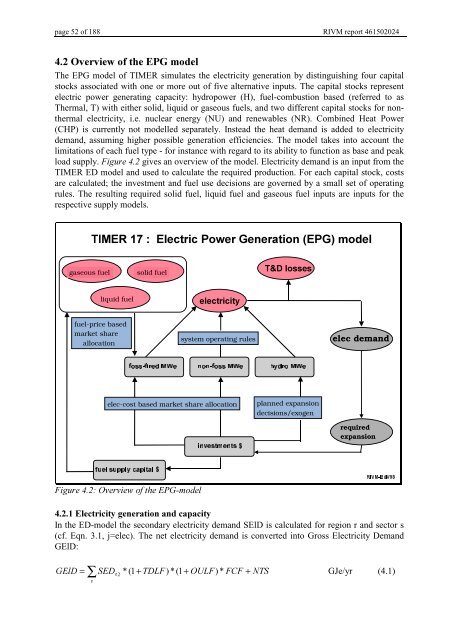Targets IMage Energy Regional (TIMER) Model, Technical ...
Targets IMage Energy Regional (TIMER) Model, Technical ...
Targets IMage Energy Regional (TIMER) Model, Technical ...
You also want an ePaper? Increase the reach of your titles
YUMPU automatically turns print PDFs into web optimized ePapers that Google loves.
page 52 of 188 RIVM report 461502024<br />
2YHUYLHZRIWKH(3*PRGHO<br />
The EPG model of <strong>TIMER</strong> simulates the electricity generation by distinguishing four capital<br />
stocks associated with one or more out of five alternative inputs. The capital stocks represent<br />
electric power generating capacity: hydropower (H), fuel-combustion based (referred to as<br />
Thermal, T) with either solid, liquid or gaseous fuels, and two different capital stocks for nonthermal<br />
electricity, i.e. nuclear energy (NU) and renewables (NR). Combined Heat Power<br />
(CHP) is currently not modelled separately. Instead the heat demand is added to electricity<br />
demand, assuming higher possible generation efficiencies. The model takes into account the<br />
limitations of each fuel type - for instance with regard to its ability to function as base and peak<br />
load supply. )LJXUHgives an overview of the model. Electricity demand is an input from the<br />
<strong>TIMER</strong> ED model and used to calculate the required production. For each capital stock, costs<br />
are calculated; the investment and fuel use decisions are governed by a small set of operating<br />
rules. The resulting required solid fuel, liquid fuel and gaseous fuel inputs are inputs for the<br />
respective supply models.<br />
7,0(5(OHFWULF3RZHU*HQHUDWLRQ(3*PRGHO<br />
gaseous fuel<br />
solid fuel<br />
7 'ORVVHV<br />
liquid fuel<br />
HOHFWULFLW\<br />
fuel-price based<br />
market share<br />
allocation<br />
system operating rules<br />
elec demand<br />
ÃIRVVILUHGÃ0:H QRQIRVVÃ0:H K\GURÃ0:H<br />
elec-cost based market share allocation<br />
planned expansion<br />
decisions/exogen<br />
LQYHVWPHQWVÃÇ<br />
required<br />
expansion<br />
IXHOÃVXSSO\ÃFDSLWDOÃÇ<br />
)LJXUH2YHUYLHZRIWKH(3*PRGHO<br />
5,90%G9<br />
(OHFWULFLW\JHQHUDWLRQDQGFDSDFLW\<br />
In the ED-model the secondary electricity demand SElD is calculated for region r and sector s<br />
(cf. Eqn. 3.1, j=elec). The net electricity demand is converted into Gross Electricity Demand<br />
GElD:<br />
*(O' = ∑ 6(' * (1 + 7'/) ) *(1 + 28/) ) * )&) + 176<br />
V2 GJe/yr (4.1)<br />
V
















